With Canada’s winter weather comes slick roadways and potentially dangerous driving conditions. In Alberta, our highway transportation operations and municipal public works staff must keep drivers safe and roads drivable above all else. Salted sand is commonly applied to roadways to increase traction and melt ice, but recent studies have shown that chloride, a component of these mixtures, is leaching into our waterbodies, contributing to the salinization of our freshwater resources.
On January 18, 2023, NSWA held a Road Salt Management Workshop, bringing technicians, public works operators, decision-makers, and researchers together to discuss their perspectives on road salt management. Attendees shared information on recent winter road management innovations, and we gained a better understanding of road salt as an increasingly complex, and emerging contaminant of concern.
Check out the speaker’s presentations here!
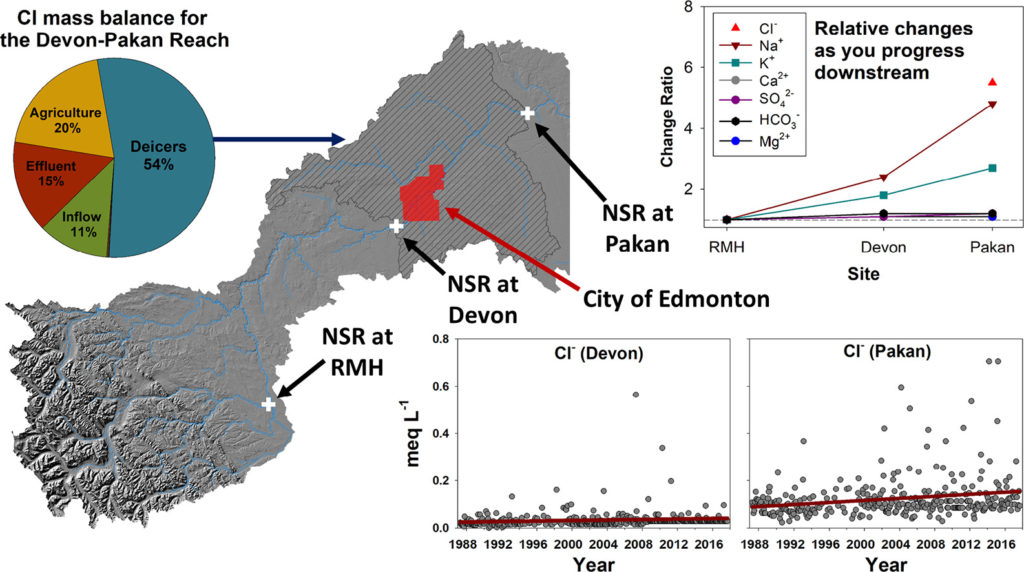
The North Saskatchewan River Watershed and Salt Contamination
Patrick Laceby, an academic researcher with the Government of Alberta, joined us virtually and presented his findings on Chloride inputs to the North Saskatchewan River Watershed. Researchers examined the concentration of a range of ions and chlorides in the North Saskatchewan River both upstream and downstream of the City of Edmonton, our watershed’s major urban hub.
Laceby and his associates found that salinization levels increased significantly as the river traveled from its western headwaters through the densely populated Edmonton Metropolitan area.
More than half (54%) of salt contaminants were linked to winter deicers, while agricultural runoff, wastewater treatment, and industrial effluent contributed the rest.

Salt in our Lakes
Continuing a focus on salinization research, we were also joined by Caleb Sinn, from the Alberta Lake Management Society. With the aid of community volunteers and citizen science through ALMS’ LakeWatch and LakeKeepers Programs, they have developed a strong, standardized data set of chemical parameters for a number of lakes in our watershed. This includes, Wabamun, Jackfish, Wizard, Half Moon, Hastings, Laurier, and Moose Lakes! This data is accessible on DataStream and the Government of Alberta Water Quality Data Portal.
Long-term trend analysis of Wabamun Lake showed steadily increasing concentrations of major ions, including chloride and magnesium. And overall, they found a significant increase in chloride levels at 16 of 18 lakes across Alberta.
Lessons Learned from Our Workshop
After learning that salt levels are increasing in both our lakes and rivers, we turned to those experienced with winter road management in our watershed to understand how municipal infrastructure and operations teams are confronting this issue. We were joined by John Potter, Operations Manager with the City of St. Albert, and Kyle Wilkin, Infrastructure Manager with the City of Leduc! Their presentations can be found here.
Winter Road Management
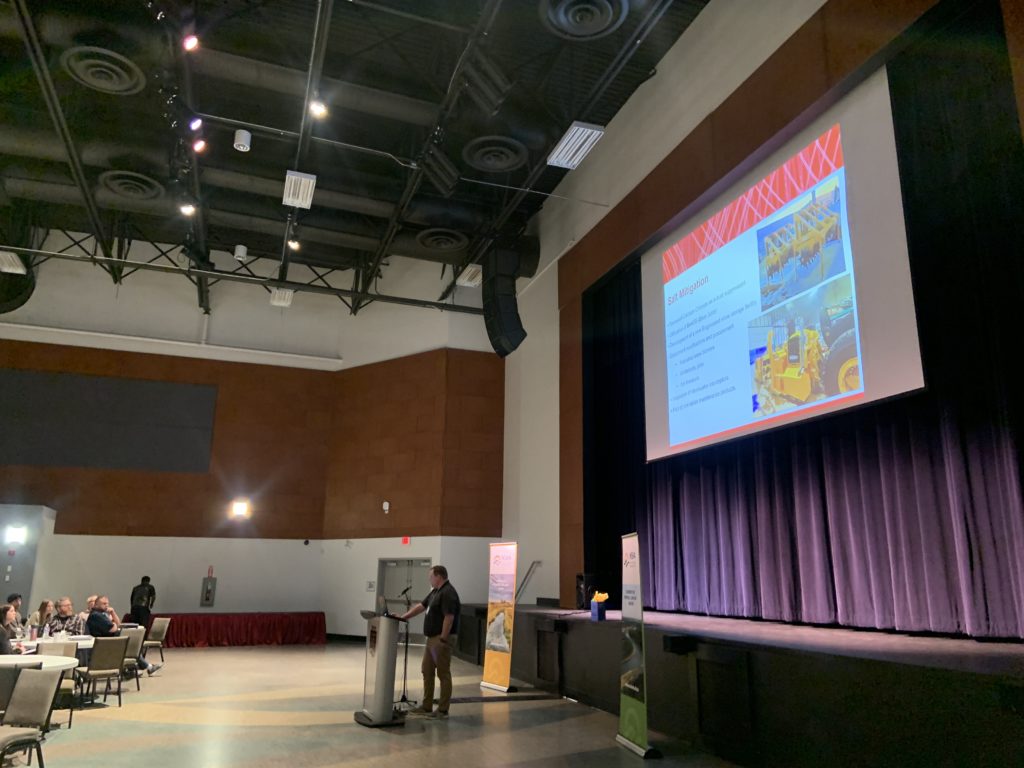
Winter road maintenance is a complex balancing act, and as we learned from our presenters, there are a number of management options, and no ‘perfect end-all solution’ as each town must contend with its own unique roadways, winter weather patterns, and budget limits. Plans must balance road safety, and vehicle wear-and-tear concerns with environmental risks and increasingly erratic winter temperatures.
So, what are a municipality’s options when roads become icey, slick and undrivable? Snowplows and graders can clear snow but upkeep is a challenge and ice usually remains a problem. Sand application is the most obvious solution for icy roadways and is commonly applied to roads and highways across Alberta. Sand is not without its cons, as it can also build up in our waterways, increasing sediment loading and harming aquatic ecosystems. However, relative to salt contamination, sand is of lesser concern, and our municipalities use sand over salt whenever possible.
Sand can also be blown off roads and it doesn’t have any deicing capabilities. This is where salt comes into play.
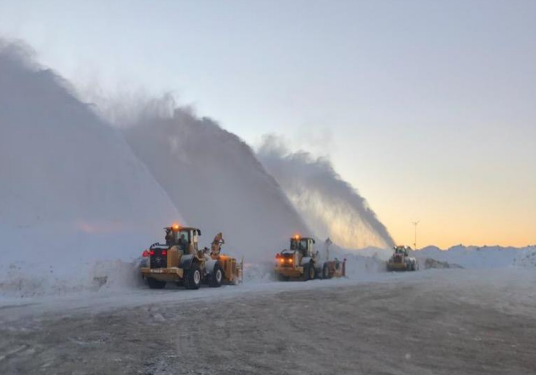
Sand Mixtures – A Carefully Balanced Concoction
The sand applied to our roadways is generally a mixture of sand, salt, and calcium chloride brine, commonly referred to as ‘pickled sand.’ The salt brine helps to wet the sand and keep it in place while melting the ice. As we learned from our municipal experts, the ratio of salt to sand is carefully considered and can differ day-to-day depending on current road conditions and weather forecasts.
Additionally, salt’s deicing capabilities are lost in particularly cold temperatures, and Road Salt Management Plans account for this, with the many towns beginning to stop salt use below -20C.
Concerns

We asked the workshop attendees what their key concerns are surrounding road salt use in our watershed. Some answers included:
-
-
Impacts on infrastructure, roads and vehicles with overapplication of road salt.
-
Climate change bringing warmer temperatures, freezing rain and more erratic freeze/thaw cycles. Changes in precipitation patterns may lead to an increased need for road salt application.
-
Knowledge gaps around the level of salt being applied in private areas, versus public operations.
-
Facts vs. Fiction surrounding the necessity of road salts and misinformation
-
Salt contaminating our soil and groundwater
-
Budget constraints
-
The Positives – Innovation and Smarter Planning
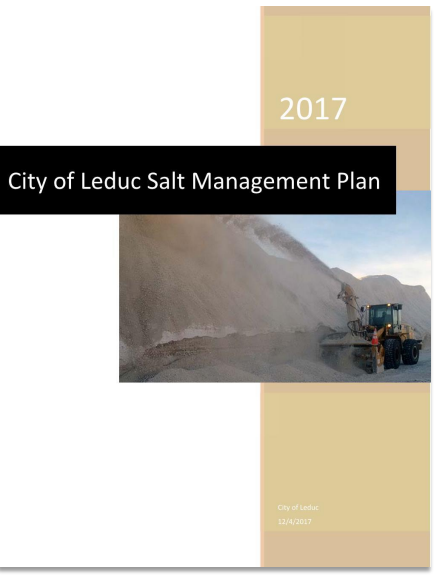
Salt Management Plans
Municipalities in Alberta are required to devise a Salt Management Plan if road salt application passes a certain level. These plans are driven by the ‘4 R’s of Salt Management:’ Right Material, Right Amount, Right Place, and Right Time.
Action items outlined in Leduc’s 2017 Salt Management Plan include: equipment upgrades, storm response and salt use record keeping, development of application rates, snow storage facility monitoring, monitoring salt vulnerable areas, increased public communications and development of a spill response policy.
Improved Storage
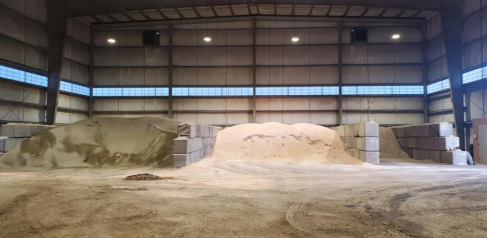
The majority of Alberta’s towns have begun storing winter maintenance materials and sand in covered facilities. These facilities are designed to prevent leaching of salts into soils and water bodies.
Improved Planning
In the City of Leduc, the salt application locations are informed by assessments of salt vulnerable areas, water bodies and drainage maps. Salt and sand is only applied to collector and arterial roads when needed, while residential roads are only treated with fractured rock. Additionally, roads are swept in the early spring to reduce contaminant movement into soils and water ways.
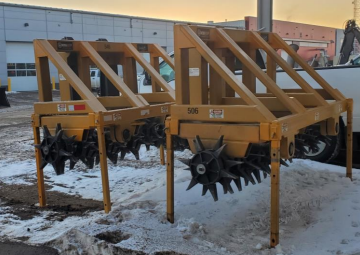
Innovation and New Technology
Snow removal equipment is improving! Industrial snow blowers, underbelly plows, and icebreakers allow for mechanical snow and ice removal, reducing the amount of salted sand required. A new sand additive is also available – Beet juice, also known as Beet55. Although this additive is more expensive than salt, it is effective and becoming more readily available. Other mitigation options also include the installation of stormwater interceptors, so salt contaminants are diverted and treated before they can enter water bodies.
Ideas and Needs for the Future
We asked our workshop attendees what they needed moving forward to improve salt management in their fields. We learned that budget constraints are a limiting factor in the development of best management practices and infrastructural upgrades. Collaboration and sharing of equipment across town’s and counties through Shared Service Agreements was emphasized as a need moving forward and a way to balance budget constraints. Our attendees also noted that ‘one size fits all solutions’ often don’t work, as weather and road conditions vary across the province. For example, the City of St Albert’s large boulevards allow for easier snow plowing, while other cities and town’s must utilize other options with differing road designs.
Participants also noted the importance of utilizing environmental monitoring and data patterns to inform road salt management practices. Mapping groundwater movement, drainage areas and vulnerable water bodies can help municipal decision-makers determine where salt should not be used sparingly for environmental protection. Some municipalities are utilizing their stormwater master plans to assess salt sensitive areas, and incorporating findings into their Salt Management Plans. However, many municipalities don’t have data like this in place, and this was identified as a barrier for more robust salt management strategies.
Working Together
As a watershed convenor, NSWA is a proponent of bringing people together to solve complex problems. Workshops like these are valuable tool for municipal decision-makers and NSWA’s stakeholders. Sharing ideas and learning from people across the region, and across varying fields and backgrounds is a great way to think bigger, share successes and inspire new ideas for innovation. We thank everyone who attended this event! Stay tuned for more work around salt management in our watershed.
